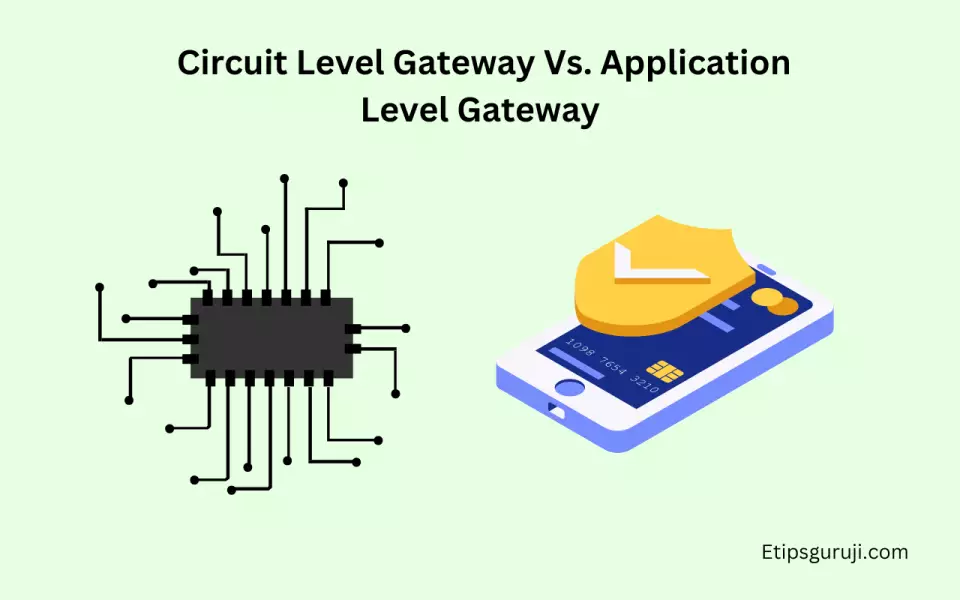Circuit Level Gateway: Purpose, Circuit Levels, and Comparison

A Circuit Level Gateway (CLG) is a type of firewall. The primary role of a CLG is to act as a relay of network traffic between two networks, typically an internal private network and an external public network such as the internet.
A CLG operates at the session layer of the OSI model, making decisions based on session information rather than inspecting the contents of each packet. The key function of a CLG is to create a virtual circuit before any data exchange occurs.
Purpose of Circuit Level Gateway
The main objective of CLGs is to provide a higher level of security than what’s offered by simple packet filtering. By establishing a connection or circuit through the gateway prior to any data transfer, the CLG ensures that all sessions are legitimate and no unauthorized traffic is permitted.
Here’s why Circuit Level Gateways are used:
- Anonymity: By acting as a relay, the CLG can hide the internal IP addresses from the external network, improving privacy and security.
- Session Validation: CLGs provide an additional layer of security by verifying sessions, ensuring only authorized connections are established.
- Efficiency: Because they work at the session layer, CLGs can provide effective security without the high computational costs associated with higher-layer firewalls.
The usage of CLGs signifies the need for advanced security measures in the modern digital era. Given the increasing sophistication of cyber threats, the implementation of protective layers such as CLGs can considerably mitigate the risk of security breaches.
Working Mechanism of Circuit Level Gateway
Session Establishment
A key feature of CLGs is the way they handle session establishment. A session is initiated whenever a system wants to send data packets to another system. For the data packets to be transmitted successfully, a connection or ‘circuit’ needs to be set up first.
The process typically involves the following steps:
- Session Initiation: An internal host attempts to connect with an external host, triggering the CLG to start the session establishment process.
- TCP Handshake: The CLG uses a process known as the TCP three-way handshake for session establishment. This process ensures that both the sender and receiver are ready for data transmission.
- Step 1: The sender sends a SYN packet to the receiver.
- Step 2: The receiver responds with a SYN-ACK packet.
- Step 3: Finally, the sender acknowledges the receiver’s response with an ACK packet.
- Virtual Circuit Creation: Once the TCP handshake is completed, the CLG establishes a virtual circuit between the internal and external hosts.
Data Transmission
During data transmission, the CLG’s function is a bit different from a standard packet-filtering firewall. Rather than inspecting every individual data packet, the CLG only checks whether the session of the data packet is valid. If the session is valid, it forwards the packet, else it discards it.
However, it’s crucial to note the following distinction:
- Packet Filtering: Involves inspecting each individual packet regardless of its associated session. This method is generally more resource-intensive.
- Circuit Level Gateway: The CLG checks if a session is valid and only then allows the corresponding packets to pass through. This approach is more efficient, but provides slightly less granular control compared to packet filtering.
Session Termination
After the data exchange is complete, the session is terminated. Session termination in a CLG typically involves either party sending a FIN (Finish) packet to signal the end of data transmission. Upon receipt of this packet, the CLG proceeds to close the virtual circuit that was established.
The session termination process is crucial for maintaining network security. By ensuring that sessions are closed promptly after use, CLGs help prevent unauthorized users from exploiting already established sessions. This aspect of CLGs contributes to their effectiveness as a firewall solution.
Comparative Analysis: Circuit Level Gateway Vs. Application Level Gateway

When talking about security gateways, it’s hard to avoid comparing Circuit Level Gateways (CLGs) and Application Level Gateways (ALGs). Both serve similar purposes but operate in fundamentally different ways.
Similarities
Before delving into the differences, let’s take a look at the common features shared by CLGs and ALGs:
- Session-based Operation: Both CLGs and ALGs operate on a session basis. They create a pathway or ‘circuit’ between two hosts before the transmission of data packets.
- Security Enhancement: Both types of gateways aim to enhance the network’s security by controlling the data flow between different networks. They check whether a session is valid before allowing the data packets to pass through.
- Privacy Protection: CLGs and ALGs can both conceal the internal network’s details from the external network, adding a layer of privacy.
Differences
Despite these similarities, CLGs and ALGs have crucial differences that impact their function, efficiency, and security level:
| Circuit Level Gateway | Application Level Gateway |
|---|---|
| Operates at the session layer of the OSI model. | Operates at the application layer of the OSI model. |
| Validates sessions without inspecting packet content. | Inspects every packet at the application layer for granular control and security. |
| Lower resource consumption due to reduced inspection requirements. | Higher resource consumption due to deep packet inspection. |
| Cannot protect against application-specific attacks. | Capable of protecting against application-specific attacks. |
| Provides less granular control over network traffic. | Provides more granular control over network traffic. |
Circuit Level Gateway in Modern Cybersecurity
Importance of CLG in Today’s Cybersecurity Landscape
Despite the evolution of advanced security measures, CLGs still play a crucial role in today’s cybersecurity landscape. They provide a valuable balance between security and performance efficiency, making them an ideal choice for many network environments.
Here’s why CLGs are still relevant today:
- Scale: For large networks handling vast amounts of traffic, the efficiency of a CLG can provide adequate security without hampering network performance.
- Simplicity: CLGs are easier to configure and manage compared to more complex firewalls, making them suitable for organizations with limited IT resources.
An example of a CLG use case is in corporate networks, where internal hosts need to communicate with external servers securely. A CLG can be set up to validate all sessions, ensuring only authorized communication occurs.
Limitations of Circuit Level Gateway
Despite their advantages, it’s also essential to acknowledge the limitations of Circuit Level Gateways:
- Application Layer Attacks: CLGs cannot protect against attacks targeting specific applications, as they do not inspect packet contents at the application layer.
- Limited Granularity: CLGs lack the granular control that comes with application-level inspection, limiting their ability to filter out certain types of malicious traffic.
In the face of modern threats, such as advanced persistent threats (APTs) and application-specific attacks, these limitations may leave networks vulnerable. Therefore, it’s vital to complement CLGs with other security measures for comprehensive protection.
Configuring Circuit Level Gateway
Setting up a Circuit Level Gateway involves several technical steps and parameters. Correct configuration is crucial to ensure optimal security and performance.
General Configuration Steps
Here’s a simplified step-by-step guide on how to set up a Circuit Level Gateway:
- Select a CLG Solution: Choose a software or hardware-based CLG solution suitable for your network environment.
- Install the CLG Solution: Follow the manufacturer’s instructions to install the CLG on your network. This usually involves installing software on a server or setting up a dedicated hardware device.
- Define Network Parameters: Define your internal and external networks. This typically involves specifying the IP addresses and subnets for your internal network and setting the default gateway to your external network (usually the internet).
- Configure Session Rules: Set rules for session initiation, transmission, and termination. This involves defining which internal hosts are allowed to initiate sessions and which external hosts they can communicate with.
Potential issues might arise during configuration, such as incorrect network parameters or incompatible software. Therefore, careful attention to detail during setup is crucial.
When troubleshooting, start by checking your network settings and rules for any obvious mistakes, and make sure your CLG software or hardware is compatible with your network environment and operating systems.
Configuring CLG for Different Environments
Depending on your specific network environment, you may need to adjust the settings of your CLG. For example, a large corporate network might require a different configuration than a small home network.
Consider the following when adjusting settings:
- Network Size: Larger networks may require more complex rules and possibly multiple CLGs for efficient performance.
- Network Usage: Networks with high traffic volumes may need to adjust session timeout settings to prevent premature termination of sessions.
- Security Needs: If your network handles sensitive data, you might need stricter rules and additional security measures.
The network environment can significantly impact the performance of a CLG. For instance, on a network with heavy traffic, a CLG with incorrect settings can cause delays or even block legitimate traffic. Therefore, it’s important to configure your CLG based on your unique network environment.
Advanced Topics in Circuit Level Gateways
In the realm of advanced cybersecurity, CLGs can integrate with other security measures and evolve with the changing landscape.
Integration with Other Security Measures
A Circuit Level Gateway can work in conjunction with other security measures for comprehensive protection. Here are a couple of examples:
- Firewalls: A CLG can serve as a second layer of defense behind a packet-filtering firewall, providing additional security by validating sessions.
- Intrusion Detection Systems (IDS): IDS can complement a CLG by monitoring network traffic for signs of a security breach that might slip past the CLG.
Proper integration with other security measures can help in mitigating the limitations of CLGs and provide a more rounded security approach.
Future of Circuit Level Gateway
As cybersecurity threats continue to evolve, so too must our security measures. Here are some potential advancements and trends in CLG technology:
- Machine Learning and AI Integration: With the help of AI and Machine Learning, future CLGs could potentially learn to detect unusual network behavior and block suspicious sessions, improving their ability to protect against unknown threats.
- Enhanced Integration: As network security becomes increasingly complex, we might see better integration of CLGs with other security measures, providing seamless and comprehensive security solutions.
In conclusion, despite their limitations, Circuit Level Gateways remain a relevant and essential part of modern cybersecurity. Their ability to balance efficient performance with robust security makes them a valuable tool in any cybersecurity professional’s toolkit.

